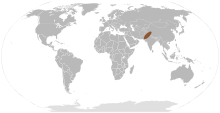Anthracobune
| Anthracobune Temporal range: Middle Eocene | |
|---|---|
 | |
| Cranial elements of members of Anthracobune | |
| Scientific classification | |
| Kingdom: | Animalia |
| Phylum: | Chordata |
| Class: | Mammalia |
| Order: | Perissodactyla[1] |
| Family: | †Anthracobunidae Wells & Gingerich 1983 |
| Genus: | †Anthracobune (type) Pilgrim 1940 |
| Species[1] | |
| |
 | |
| The inferred range of Anthracobune | |
Anthracobune ("coal mound") is an extinct genus of stem perissodactyl from the middle Eocene of the Upper Kuldana Formation of Kohat, Punjab, Pakistan.
The size of a small tapir, it lived in a marshy environment and fed on soft aquatic plants. It is the largest known anthracobunid. This group was formerly classified with proboscideans.
Notes
- ↑ 1.0 1.1 Cooper, L. N.; Seiffert, E. R.; Clementz, M.; Madar, S. I.; Bajpai, S.; Hussain, S. T.; Thewissen, J. G. M. (2014-10-08). "Anthracobunids from the Middle Eocene of India and Pakistan Are Stem Perissodactyls". PLoS ONE 9 (10): e109232. doi:10.1371/journal.pone.0109232. PMID 25295875.
References
- Kumar, Kishor (1991). "Anthracobune aijiensis nov. sp. (Mammalia: Proboscidea) from the Subathu Formation, Eocene from NW Himalaya, India". Geobios 24 (2): 221–39. doi:10.1016/s0016-6995(91)80010-w. OCLC 4656806310.
- Pilgrim, G. E. (1940). "Middle Eocene mammals from north-west Pakistan". Proceedings of the Zoological Society. B (London) 110: 127–152.
- Sahni, A.; Kumar, K. (1980). "Lower Eocene Sirenia, Ishatherium subathuensis, gen. et sp. nov. from the type area, Subathu Formation, Subathu, Simla Himalayas, H. P." (PDF). Journal of the Palaeontological Society of India. 23&24: 132–5. Retrieved July 2013.
- Wells, N.A.; Gingerich, P.D. (1983). "Review of Eocene Anthracobunidae (Mammalia, Proboscidea) with a new genus and species, Jozaria palustris, from the Kuldana Formation of Kohat (Pakistan)" (PDF). Contrib. Mus. Pal. Univ. Michigan 26 (7): 117–139. OCLC 742731409.